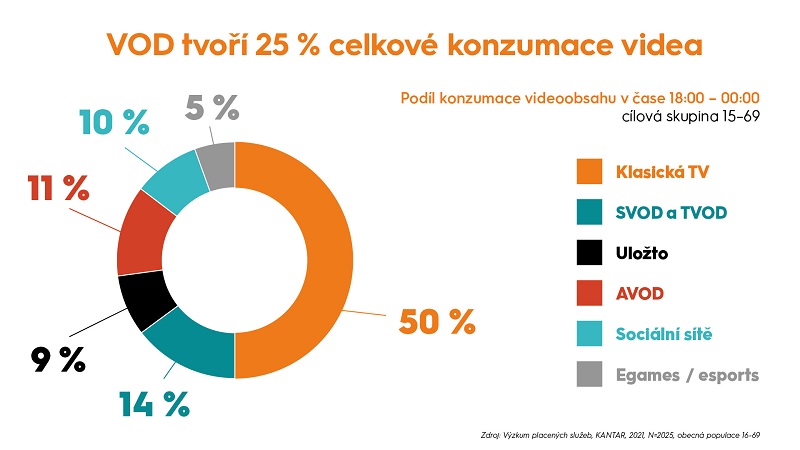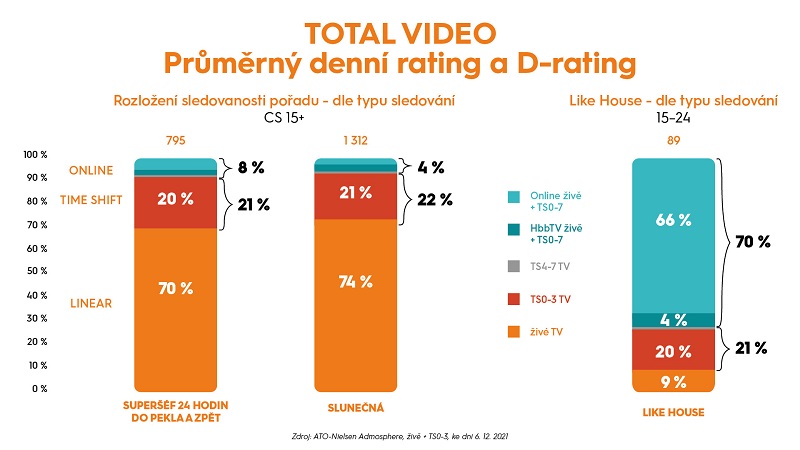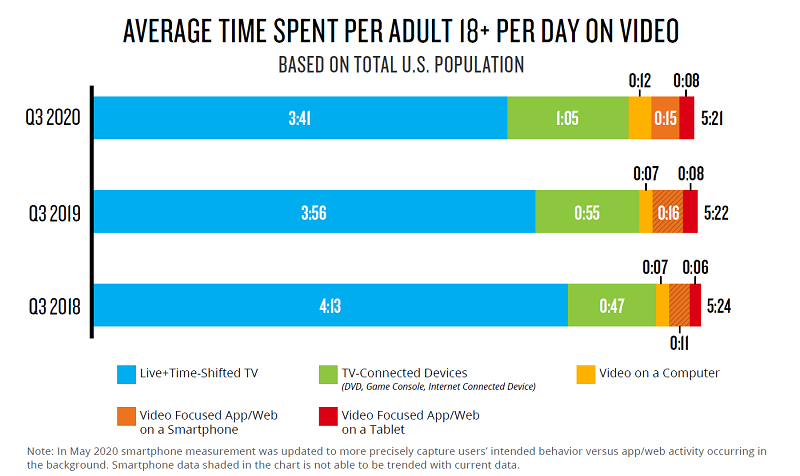Since the beginning of the year, the Prima media group, in cooperation with the research company Nielsen Admosphere, has launched a project to measure aggregate video advertising viewership across TV and digital. The project, referred to as AdCross, allows to calculate the viewership of an online campaign on Prima TV's online media, including viewership on HbbTV, and link it to the viewership of a TV campaign. It will thus include TV advertising as well as video advertising in internet browsers and HbbTV. Measurement of teasers and video advertising in mobile apps is also to be added later in the year.
The project should be an important step towards establishing a single currency for measuring "total video" on the Czech market. Therefore, Czech Television is also participating in the project. It is being implemented with the approval of the industry association ATO, which is the commissioner of the uniform measurement of TV viewership.
Media agencies already have the data to aggregate the overall impact of TV and digital advertising campaigns in Adwind Kite and can work with it. Prima is already using it in its ad trading. According to researchers from Nielsen Admosphere, the Czech Republic is the first country to have come this far in the combined measurement of TV and online video advertising. "No one has yet got to the point where media agencies have all data in one system and that data is linked. The linkage in the system is unique. There are measurement methods in the world, but also due to the strong position of HbbTV on the Czech market, AdCross is exceptional," says Tereza Šimečková, Chairwoman of the Board of Nielsen Admosphere. We also spoke about the project with Vladimír Pořírek, Commercial Director of Prima Group, and Michal Jordan, Vice Chairman of the Board of Nielsen Admosphere.
What does the launch of the AdCross project mean for the Czech market?
Tereza Šimečková: We consider it to be a breakthrough and globally unique - both technologically and methodologically. Thanks to Prima's openness and the support of Czech Television, we have launched a new product for measuring video advertising. It's a way that is being addressed in all the developed world markets. So far, our project delivers data on Prima's campaigns, and in the spring it will be extended to Czech Television. However, the project will continue to evolve with additional categories, adding data measuring video advertising on mobile apps over the course of the year, and eventually data on IPTV advertising. It's a big project that complements Prima's existing TV measurement and PEM-D digital content measurement. We will be very happy if this measurement becomes a single currency once the various parameters and details are agreed between all market players.
Vladimír Pořízek: We started working on the project almost two years ago. We see that the share of IPTV, online video, delayed viewing and viewing of content via different platforms is growing. Trends are shifting around the world, for example, in Sweden video viewership outside of linear TV is 50 %, and in the UK it is similar. In our country it is still a relatively small proportion, but when you add in deferred viewing on IPTV and consumption of services like Netflix, the proportion increases. We already have a video on demand share of both AVOD and SVOD above 20 %. It is therefore clear to us that the market will see a decline in TV linear GRPs. We lost about 30,000 GRPs last year due to the over-spinning of advertising by IPTV operators, which already represents hundreds of millions of Czech crowns. That is why we are interested in the emergence of cross-platform measurement of online and TV advertising.
Michal Jordan: The main goal of this project is to measure the reach of video ads and trailers, regardless of the platform on which the video ads or trailers occur. The user sees the result of the reach in one window in the software, which is a radical change from what has been here before.
The main difference between AdCross and the PEM-D digital content measurement project, which has been part of TVmetric since 2018, is that it measures advertising?
Tereza Šimečková: PEM-D implemented for the ATO partially measures video advertising, but without crossplatform reach. It primarily measures viewership of shows on digital platforms, we also report socio-demographic profile for shows using the demographics module, but the market is gravitating towards having a combined reach and socio-demographic profile for advertising as well. AdCross connects TV and digital platforms and clearly shows total reach as well as TV-only and online-only reach and overlay.
For online campaigns, outputs are reported in total views (impressions) and in the number of unique individuals?
Vladimír Pořízek: Yes, we used to call it eGRP, which is not entirely accurate, but we had to name some of the online inventory that we include in the bundle. When a client orders a GRP in CS 15-69 where 3 % online is part of the bundle, eGRP is a metric for us to transfer that part to online. In AdCross, you can see results in both impressions and TRPs, for TV and online, individually and combined.
 Sample AdCross project output in Adwind Kite software
Sample AdCross project output in Adwind Kite softwareComputational indicators in AdCross measurement
- Unique Audience
- Reach
- Impressions
- TRP
- OTS
How complicated was it to come up with a solution for calculating aggregate reach?
Michal Jordan: We started from mathematical models that we already knew to some extent. Probably the most difficult part of this measurement is the technology part, because it consists of a number of things: measuring video ads from the web browser, measuring HbbTV and, in the future, measuring mobile apps, and it was not easy to combine all of that. We don't have everything 100% ready yet, we will be fine-tuning the project throughout the year.
Tereza Šimečková: The project is really very extensive. Both Prima and Czech television have to deploy the measurement codes to all their platforms, it was hundreds of hours of work at Prima, more at Czech television and thousands of hours of work by our developers, analysts and others on the preparation and implementation of the whole system. The data that is collected using scripts needs to be combined with the information that at a certain moment an ad has been tracked. This is then combined with aggregated and anonymised data from the Czech National Panel to describe the socio-demographics of video advertising in players. This gave us data for digital platforms, but we also added the viewership from TV meters that Prima has from the ATO project. This is then all linked together in the Adwind Kite software. We've prepared new modules where the heavy processing, linking and actual analysis takes place.
AdCross measures socio-demographics using the Czech National Panel, while TV meters have its own panel to describe socio-demographics. How did you link these data?
Michal Jordan: We used a mathematical model that we have tested for years and whose basis is very similar to the one used by Nielsen in America. This is the principle on which individual media agencies usually link data in their own products. This is done in a similar way all over the world. But as we said, nowhere in the world do they have linked data in one software.
Prima also wants to prevent ad rollovers at IPTV operators, where it envisages several variants of ad deployment. How will this "IPTV advertising" be measured in AdCross?
Vladimír Pořízek: We are working with the operators on three ways to prevent the overlaying of ads. The first two are to prevent ad skipping, where the ad is measured by peoplemeters as deferred viewership as before - and AdCross is not needed for that. Only the third way is to replace linear advertising with embedded online advertising. In the first phase, embedded advertising in this way will not be measured by Nielsen, but will be sold as standard online advertising. When Nielsen is ready with the measurement, then this data can also be combined with the TV project data within AdCross. We hope that will be in the third quarter.
Tereza Šimečková: Our goal is to have this embedded advertising included in the AdCross measurement as well.
Isn't it a problem from a cumulative reach perspective if only a portion of the advertising is tracked within IPTV?
Tereza Šimečková: It depends on how the reach parameters are defined and what the conditions for the minimum length of viewing are. It is necessary to find a consensus on these parameters among the players on the Czech TV market. Now we have set the parameters to the default values based on the agreement with Prima, but we expect them to evolve over the course of the year. If AdCross is to become the basis of a single currency for online video advertising on the ATO's platform, these parameters must be agreed by all players.
Vladimir Pořízek: The International Television and Radio Association EGTA has issued a statement on what parameters such projects should meet. We want to rely on them. For example: viewing at normal playback speeds, full viewability, professionally produced video content that the broadcaster has full control over, and in no case user-generated content. Also important is the length of the unskippable ad spot, which we currently set at a minimum of 15 seconds, but will most likely extend...etc. There is a whole range of things.
Michal Jordan: So it is very important what content is measured. This should be discussed in the market, and if the measurement is to cover the whole market in the future, there should be a gradual consensus on this. Similarly, after the data already existed, there were previous methodological issues in the market, such as the inclusion of timeshare in the data in the past. To find the right parameters, it is very often necessary to have some measured data first.
“We would be very happy if, once the various parameters and details are agreed between all market players, this measurement becomes a common currency.”
Is it possible to say in general how many GRPs are currently generated in online campaigns in the Czech market?
Vladimír Pořízek: It's about how we define these GRPs. If we take it according to how we currently define them, there are about 4% of such inventory on the whole market. Of that, our online inventory for bundled sales is only about 1.5%. But that only takes into account standard online: web-browser, HbbTV, mobile, but no longer IPTV operators and their deferred viewing and second screens. Moreover, this is how it is for the general population. In younger target groups the share of online can be much higher. Our experience with the show Likehouse shows that more than 50% of the total viewership of the show was the youngest target group aged 15-24 online. In our industry and around the world, it has become quite common that the term TV does not refer to linear television, but to "total video" - the viewing of professional content across all possible platforms. Second screen devices such as mobiles or tablets, computers and various smart TV apps are growing steadily and will grow in the future and need to be measured.
 Source: Kantar Paid Services Research, Kantar 2921, N = 2025, general population 16-69
Source: Kantar Paid Services Research, Kantar 2921, N = 2025, general population 16-69 Source: ATO-Nielsen Admosphere, live + TS0-3 as of 6/12/2021
Source: ATO-Nielsen Admosphere, live + TS0-3 as of 6/12/2021 Average time U.S. adults spend watching video, 3Q/2018-3Q/2020, source: Nielsen
Average time U.S. adults spend watching video, 3Q/2018-3Q/2020, source: NielsenWill agencies work with AdCross, will they adopt the project?
Vladimir Pořízek: From the beginning, our goal is to have a uniform acceptance of the project, and we know from the market that agencies welcome it as well. It is obvious that GRPs in linear TV are decreasing and that the consumption of online video is growing. We need to work with that and respond to that evolution.
Michal Jordan: A step like this is inevitable so that people metrics don't lose authority. Peoplemetric data will be the vehicle to which more will be added over time. In our view, this is the way to maintain a single currency in the market without starting to use proprietary data as the main data source. A company that implements official "peoplemeter" measurements must be reasonably conservative and not allow the measurements to introduce instability into the industry. And on the other hand, it must ensure that the development of measurement reflects the fundamental issues of the industry. That crossplatform reach of digital video advertising is an absolutely critical issue today is probably something that all market players agree on. Nielsen offers its synergy and expertise to build on the AdCross experience to create an extension of official ATO measurement that is accepted by the entire market.
Source: mediaguru.cz

